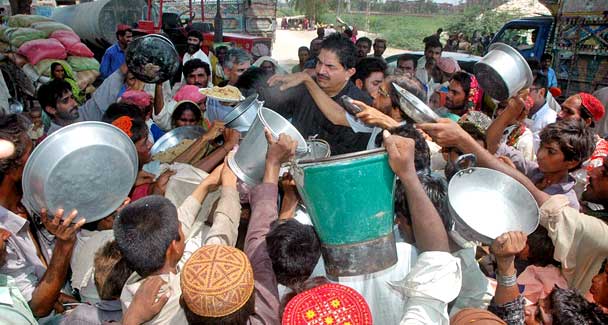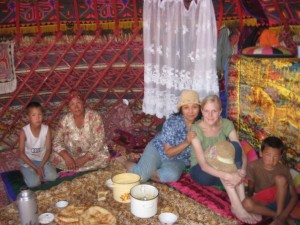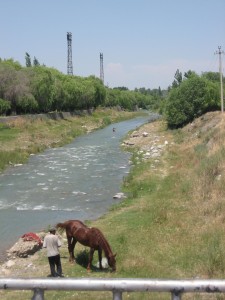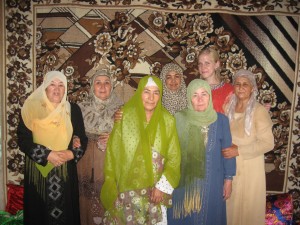The cover of the August 9 edition of Time magazine was designed with shock and awe in mind. It shows a picture of Bibi Aisha, a young woman from Afghanistan whose nose and ears had been cut off. The photo was accompanied by the headline: “What happens if we leave Afghanistan”.
I’m sure it’s just a coincidence that Gen. David Petraeus almost simultaneously began giving interviews to The New York Times, the Washington Post, NBC, Meet the Press and others voicing his opinion that a withdrawal of troops from Afghanistan would be unwise.
Normon Solomon wrote an article in Common Dreams.org today, “Gen. Petraeus Goes to Media War,” which says: “Let’s be clear about what’s happening here. The top U.S. military commander in Afghanistan, with the evident approval of the White House, has launched a fierce media blitz to cripple the policy option of any significant military withdrawal a year from now. Riding high in what is supposed to be a civilian-run military, Petraeus is engaging in strategic media operations to manipulate what should be a democratic process on matters of war and peace.” http://www.commondreams.org/view/2010/08/16Solomon, author of “War Made Easy: How Presidents and Pundits Keep Spinning Us to Death” and president of the Institute for Public Accuracy http://www.accuracy.org/, visited Kabul last year.
Lucinda Marshall said Monday, “On Meet the Press on Sunday, Petraeus cited the recent Time cover story featuring a young Afghan woman with her nose cut off. Said Petraeus: “If you lose, it has, I think, some significant repercussions, not just for this country, although they would be enormous, and start with the cover of Time magazine for starters.”
Marshall is director of the Feminist Peace Network, which just posted the article “Time’s Story About Afghan Women – Questions Raised About Author’s Vested Interests And Accuracy Of The Story.”
But you don’t have to be an American to see the dangers of the military setting a nation’s agenda.
This is from an article by Tony Iltis in Green Left, an Australian-based alternative weekly that describes itself as “a proudly independent voice committed to human and civil rights, global peace and environmental sustainability, democracy and equality.” Tony’s article was headlined, accurately, I believe, “‘Time’ exploits victim to promote war.”
“…what happened to Aisha took place in Afghanistan under Western occupation.
“In return for allowing Time to publish her photo, Aisha was flown to the US for reconstructive surgery. However, although Time ensured her mutilated face was seen worldwide, they appear less keen for her voice to be heard.
“I heard Aisha’s story from her a few weeks before the image of her face was displayed all over the world”, Ann Jones, author of Kabul in Winter, wrote in the August 12 Nation. “She told me that her father-in-law caught up with her after she ran away, and took a knife to her on his own; village elders later approved, but the Taliban didn’t figure at all in this account.
“The Time story, however, attributes Aisha’s mutilation to a husband under orders of a Talib commander, thereby transforming a personal story, similar to those of countless women in Afghanistan today, into a portent of things to come for all women if the Taliban return to power.”
In March, Wikileaks published a CIA document that outlined a strategy to counter growing opposition in Europe to participation in the US-led occupation. It recommended using a narrative about the oppression of women in Afghanistan that highlighted the Taliban’s misogynist violence while ignoring that of the pro-occupation warlords and the occupation armies.
Afghan feminist Malalai Joya condemned the pro-war media manipulation. “During the Taliban’s regime such atrocities weren’t as rife as it is now and the graph is hiking each day”, she told France 24 on August 1.
“Eighteen-year-old Aisha is just an example and cutting ears, noses and toes, torturing and even slaughtering is a norm in Afghanistan
“ … The US used the plight of Afghan women as an excuse to occupy Afghanistan in 2001 by filling television screens, internet pages and newspapers with pictures of women being shot down or beaten up in public.
“Once again, it is molding the oppression of women into a propaganda tool to gain support and staining their hands with ever-deepening treason against Afghan women.”
Malalai Joya, who also is a politician the BBC called “the bravest woman in Afghanistan” for denouncing the warlords in the parliament, toured the United States earlier this year in an effort to get support for pulling out U.S. troops from her country.
This was her message to Americans:
“Democracy will never come to Afghanistan through the barrel of a gun, or from the cluster bombs dropped by foreign forces. The struggle will be long and difficult, but the values of real democracy, human rights and women’s rights will only be won by the Afghan people themselves.
“So do not be fooled by this façade of democracy. The British and other Western governments that claim to be bringing democracy to Afghanistan ignore public opinion in their own countries, where growing numbers are against the war.
“In my tours to countries that have troops in Afghanistan, I’ve met many bereaved parents who have lost their loved ones in the war in my home. I am very sorry to see governments putting the lives of their soldiers in danger in Afghanistan in the name of bringing democracy. In fact the soldiers are serving the strategic and regional interests of the White House and the consequences of their occupation so far have been devastating for my people.
“The worst casualty of this war is truth. Those who stand up and raise their voice against injustice, insecurity and occupation have their lives threatened and are forced to leave Afghanistan, or simply get killed.
“We are sandwiched between three powerful enemies: the occupation forces of the U.S. and NATO, the Taliban and the corrupt government of Hamid Karzai.
“My people are fed up. That is why we want an immediate end to the U.S. occupation.”
But, of course, the current media blitz by Gen. Petraeus and his willing media accomplices isn’t aimed at the people of Afghanistan. It’s aimed at us.
Where do you stand? What will you do?
(From Ethan Casey’s blog: Reporting with Respect, used with permission.)
SEATTLE, AUGUST 13 – Yesterday a non-Pakistani friend here emailed me: “I wanted to ask you which you think would be the best organization to make a donation to for the current crisis in Pakistan. We usually give to MSF, but their website doesn’t seem to offer the opportunity to give specifically for Pakistan. Can you offer advice?”
This friend is British and greatly prefers British media outlets, but I need to believe that there are many Americans who also want to help flood victims in Pakistan – or who would want to, if they knew the scale and severity of the disaster.
Why don’t they know? We can, and I do, blame “the media,” but that’s unhelpful and ultimately a cop-out. Each of us individually has the opportunity and responsibility to be aware of every tragedy in our world, and we should be willing to exert ourselves to redress them. We’re all in this together. But the real problem is that there’s too much tragedy, and it’s happening too fast, and these days Americans are distracted and confused and worried about serious problems close to home, like our own jobs and mortgages.
This is understandable. But you need to know that all indicators are pointing toward an enormous, long-term human tragedy unfolding in Pakistan, and we need to do something about it, for several good reasons. The New York Times acknowledged one of these when – belatedly, in its first significant coverage of the floods that I noticed – it headlined an August 6 article “Hard-Line Islam Fills Void in Flooded Pakistan.”
A related point is that we Americans owe Pakistanis a measure of basic human respect and compassion, as well as gratitude specifically for the sacrifices they’ve made at our behest in several wars in Afghanistan. When we repay this debt, it will also redound to our benefit. “It’s high time we showed Pakistanis the best of America,” a disaster relief specialist told me last year. “If you’re a true friend, you don’t run out on somebody when you don’t need them anymore. … Pakistanis don’t trust America anymore. We need to show Pakistanis who we really are.”
Todd Shea runs a charity hospital in the Pakistan-administered portion of the disputed region of Kashmir, where he has been working since the October 2005 earthquake that killed 80,000 people. He also responded urgently and effectively to the World Trade Center attack, the Asian tsunami, Hurricane Katrina, and the earthquake this January in Haiti. He’s currently on the ground in Pakistan, running medical camps and providing drinking water, food, and other relief. An August 11 update on the floods suggests the scale of the challenge:
In a recent statement appealing for more aid to Pakistan, UN humanitarian chief John Holmes said: “While the death toll may be much lower than in some major disasters, taking together the vast geographical area affected, the numbers of people requiring assistance and the access difficulties currently affecting operations in many parts of the country, it is clear that this disaster is one of the most challenging that any country has faced in recent years.
Thousands of people are camped out on roads, bridges and railway tracks – any dry ground they could find – often with nothing more than the clothes on their backs and perhaps a plastic sheet to keep off the rain. ”I have no utensils. I have no food for my children. I have no money,” said one survivor, sitting on a rain-soaked road in Sukkur along with hundreds of other people. ”We were able to escape the floodwaters, but hunger may kill us.” …
There is a desperate need to send more well-equipped medical teams to the flood-hit areas to prevent the further spread of disease. The victims of the flood have lost everything and cannot cope with potential epidemics on their own.
I’m writing this article because I live and work between two worlds: the mainstream North America that I come from, and the Pakistani immigrant community. My job is to help bridge the gulf in awareness and sympathy between those worlds. What I’m seeing right now is that Pakistani-Americans and their admirable and effective nonprofit groups are jumping once more into the breach, as they always do. And, as always, they’re confined – and confining themselves – to soliciting funds from each other.
The flooding is “well timed” in the sense that the fasting month of Ramadan has just begun, and many Muslims will be directing their annual charity contributions toward flood relief. Pakistani-Americans are generally an affluent community, but there’s a limit to what they can do. Wealthy Pakistanis in Pakistan also need to help, and surely are helping. Just as important, we non-Pakistani Americans and Canadians must help. We also must somehow self-raise our own awareness, given the paucity of decent media coverage. This is important both for obvious-enough political reasons, and simply because it’s the right thing to do.
I see troubling contrasts between the outpouring of generosity and attention that followed the earthquake in Haiti and the averting of eyes from the flooding in Pakistan. I see several reasons for this: Haiti is nearby; the earthquake killed 200,000 or more people all at once. In addition, though, there’s the fact that Haiti is not a Muslim country. The earthquake fit right in with the story we were already telling ourselves about Haiti, which is all about poverty and tragedy. Dr. Paul Farmer sums it up pithily in the title of his book The Uses of Haiti. The uses of Pakistan are different. We need to move beyond the uses of both countries and toward understanding them accurately and respectfully, in their own terms. Our awareness of Haiti should be more political and of Pakistan less so, or differently so.
Anyway, back to my friend’s question. The short answer is that, as always, grassroots groups are more nimble and effective, and your money will be put to better use if you give it to groups that are nearer the ground. This is why the nonprofit groups founded and run by Pakistani-Americans are crucially important. I’m including links to several of these below, and I recommend them all.
I was jolted the other day when another friend suggested that being asked to donate to the excellent Islamic Medical Association of North America “could possibly turn some people off.” He’s probably right, but shame on them if so. We need to get over our knee-jerk aversion to the word “Islamic.” Your doctor might be a member of IMANA. As a Haitian woman told Paul Farmer years ago, “Tout moun se moun” – all people are people. We’re all in this together.
Please contribute to flood relief in Pakistan through one of these organizations (listed in alphabetical order):
Ethan Casey is the author of the travel books Alive and Well in Pakistan: A Human Journey in a Dangerous Time (2004) and Overtaken By Events: A Pakistan Road Trip (2010) He is currently writing Bearing the Bruise: A Lifetime in Haiti for publication in spring 2011. He can be emailed at ethan@ethancasey.com and his books and articles are available online at www.ethancasey.com/books and www.facebook.com/ethancaseyfans. Until further notice, he is donating 20% of profits from sales of his Pakistan books to flood relief in Pakistan, and from his Haiti book to the Colorado Haiti Project.
The following material about what it means to be an American is an excerpt from an article by Valeria Fernández, at 90DAYSTOPHOENIX. You can read the full story here. This is part four of an ongoing series of videos I’m using with permission.
 90DAYSTOPHOENIX.com is an independent media project that has been documenting Arizona’s ongoing struggle to “sift through the truth and lies behind the immigration debate.” Journalists, photographers, filmmakers and others are working together to give a real-time on-the-ground account of Arizona’s controversial new immigration law – SB 1070 – that will take effect tomorrow. Another goal of the project is to show as large an audience as possible how this new law will effect people throughout the state.
90DAYSTOPHOENIX.com is an independent media project that has been documenting Arizona’s ongoing struggle to “sift through the truth and lies behind the immigration debate.” Journalists, photographers, filmmakers and others are working together to give a real-time on-the-ground account of Arizona’s controversial new immigration law – SB 1070 – that will take effect tomorrow. Another goal of the project is to show as large an audience as possible how this new law will effect people throughout the state.
According to the Associated Press, “A federal judge on Wednesday blocked the most controversial parts of Arizona’s immigration law from taking effect, delivering a last-minute victory to opponents of the crackdown. The overall law will still take effect Thursday, but without the provisions that angered opponents — including sections that required officers to check a person’s immigration status while enforcing other laws. The judge also put on hold parts of the law that required immigrants to carry their papers at all times, and made it illegal for undocumented workers to solicit employment in public places.”
What does it mean to be an American?
Is it defined by being born in a place? Is it the color of your skin? Is it the papers you carry? Is it marked by the desire to defend the Constitution? Or is it to be a Tea Partier?
More important, can a person who crosses the border illegally be an American?
Our politicians don’t think so. They want to banish 460,000 people, some of whom have lived here for decades, for not having the papers to prove that this is where they belong.
I have seen the anti-immigrant climate escalate over the past three years as I’ve worked on a film about the politics of immigration in Maricopa County with director Dan DeVivo. And recently we created wwww.90daystoPhoenix.com to document the three-month period before SB 1070 goes into effect on July 29, barring a successful court challenge.
Latinos have a reason to be upset, worried and even fearful about a law that is breeding hatred and resentment against them.
Yes, I know there are provisions in SB1070 supposedly intended to prevent racial profiling, but the other language of the law encourages it. I donʼt believe that all police officers in the state want to racially profile people. But they are required to enforce SB 1070, and if they don’t, their bosses–the cities, counties and the state itself–face citizen lawsuits.
The police find themselves between a rock and hard place.
Just watch this video of Juan Miguel Gonzales, a U.S. citizen whose wife was detained and deported after they were pulled over for a questionable traffic infraction last month. Despite being a U.S. Citizen he feels this will result in his own “deportation” because now he has to leave Arizona to reunite with his wife.
Other harsh immigration laws in the state target the economic migrant and mistakenly racially profile Latinos citizens too. Such cases have already made their way into federal courts in Arizona.
A law like SB 1070 didn’t happen overnight, it took a long time for politicians to convince Arizona voters with the idea that we are being invaded by “illegal aliens” who sell drugs, cause mayhem and take American jobs and deplete public benefits.
These lies have become sound bites that voters believe. In truth, crime is down in Arizona and unauthorized migrants are barred from most public benefits.
For more information on the 90DAYSTOPHOENIX project, click here.
This video, made by Jason Aragon from PanLeft, shows one of the many acts of civil disobedience taking place in Arizona as the date for SB 1070 to go into effect comes close.
 This is part three of an ongoing series of videos I’m using with permission.
This is part three of an ongoing series of videos I’m using with permission.
90DAYSTOPHOENIX.com is an independent media project that has been documenting Arizona’s ongoing struggle to “sift through the truth and lies behind the immigration debate.” Journalists, photographers, filmmakers and others are working together to give a real-time on-the-ground account of Arizona’s controversial new immigration law – SB 1070 – scheduled to take effect July 29.
Another goal of the project is to show as large an audience as possible how this new law will effect people throughout the state.
Seven people were arrested by Phoenix Police on Thursday outside the U.S. District Court in Phoenix while the federal government was presenting arguments against the new law that makes it a state crime to be an undocumented immigrant. Activists are calling for widespread nonviolent actions all across the state on the day the law goes into effect.
For more information on the 90DAYSTOPHOENIX project, click here.
90DAYSTOPHOENIX.com is an independent media project that has been documenting Arizona’s ongoing struggle to “sift through the truth and lies behind the immigration debate.” Journalists, photographers, filmmakers and others are working together to give a real-time on-the-ground account of Arizona’s controversial new immigration law – SB 1070 – scheduled to take effect July 29.
 Another goal of the project is to show as large an audience as possible how this new law will effect people throughout the state. This is part two of an ongoing series of videos I’m using with permission.
Another goal of the project is to show as large an audience as possible how this new law will effect people throughout the state. This is part two of an ongoing series of videos I’m using with permission.
Civil Rights Attorney, Richard Martinez explains how Arizona’s SB 1070 differs from Federal Immigration Law.
Martinez is one of the attorneys involved in two lawsuits representing police officers in Phoenix and Tucson that believe the new law would force them to violate the U.S. Constitution. It would specially put them in a difficult situation when they come in contact with minors on schools, said Martinez.
“There’s nothing that protects minors, it compels all persons there’s no age distinction on 1070,” he added.
The first hearing took place last Thursday in front of judge Susan Bolton. The impact to students was raised as a key concern by the litigants.
90DAYSTOPHOENIX.com is an independent media project that has been documenting Arizona’s ongoing struggle to “sift through the truth and lies behind the immigration debate.” Journalists, photographers, filmmakers and others are working together to give a real-time on-the-ground account of Arizona’s controversial new immigration law – SB 1070 – scheduled to take effect July 29. Another goal of the project is to show as large an audience as possible how this new law will effect people throughout the state.
 The law, which now faces a federal suit, has been called one of the ‘toughest legislations in the nation.’ It means that all immigrants in Arizona must now carry their alien registration documents and it means that police can question anyone they think may be in the United States illegally. It will also address people that knowingly hire illegal immigrants or who transport them.
The law, which now faces a federal suit, has been called one of the ‘toughest legislations in the nation.’ It means that all immigrants in Arizona must now carry their alien registration documents and it means that police can question anyone they think may be in the United States illegally. It will also address people that knowingly hire illegal immigrants or who transport them.
In two separate hearings in a Phoenix courtroom on Thursday, attorneys representing a broad coalition of civil rights groups and the U.S. Department of Justice argued that portions of SB 1070 need to be enjoined because they usurp the federal government’s authority to regulate immigration law. Judge Susan Bolton gave no indication of when she might rule on the case.
While we wait for a decision, I will (with permission) be re-posting some of the videos produced by the 90DAYSTOPHOENIX project.
In this video, independent journalist, Valeria Fernandez, put’s Sheriff Joe Arpaio’s 287g illegal immigration enforcement powers into perspective. What is 287 County? 287g County, aka Arizona’s Maricopa County, is the home of 500,000 undocumented immigrants. They account for about 8% of the state’s workforce. In the wake of a series of new laws that target undocumented labor and empower the local police to enforce federal immigration laws, immigrants and their families are subject to daily persecution. In Maricopa, Sheriff Joe Arpaio has the largest police force in the nation enforcing a section of immigration law known as 287(g) that allows the federal government to deputize local police to act as immigration agents.
About the author:
Natalia M. Wobst, a June 2010 graduate of the Russian, Eastern European, and Central Asian Studies Program at the University of Washington, spent two months last summer in the city of Osh in southern Kyrgyzstan, which was at the heart of the recent unrest. Here Natalia was enrolled in the American Councils’ Eurasian Regional Language Program, lived within an Uzbek host family, received intensive Uzbek language instruction and conducted research for her Master’s Thesis – “Local Impact on Secondary Educational Reform in Post-Soviet Kyrgyzstan.”
Uzbeks, who have in the past led a more sedentary life compared to the, formerly pastoral, nomadic Kyrgyz, command a significant monopoly on the economy in the South. The Uzbek and Kyrgyz languages are a related, but distinct, Turkic languages. Interim President Otunbaeva estimates the official toll of lives lost (several hundred) in the deadliest ethnic violence on post-Soviet space to be about ten times lower than it should be. Surprising international observers, most refugees who fled abroad – often returning to burnt edifices where their houses once stood – were back in the country by June 28th, due to strong encouragement to participate in a constitutional referendum, which would grant legitimacy to the new government and sanction a parliamentary system.
In considering what is next for Kyrgyzstan, the author takes a closer look at the Uzbek community’s values, language, and religious traditions. Through anecdotes from her experience in Kyrgyzstan in the summer of 2009, she draws our attention to the fact that this is not a community predestined to civil war. The problem instead lies in the Uzbeks’ situation within a weak state with intricate borders dating back to the Soviet Union, which lacks the means to fully support and integrate its diverse populace. Such a situation can be easily manipulated by sub-national groups, reacting to what they perceive as their disregarded social, economic, and political needs. Only a year ago, things looked markedly different.
On July 1, 2009, when I wrote family and friends from my temporary home in Osh, Kyrgyzstan, I described a much more peaceful scene than is conjured when people try to visualize the city of the southern region, wrought by inter-ethnic riots only one year later. As the only student that summer who was enrolled in American Councils’ Eurasian Regional Language Program in Kyrgyzstan and the first American to study in Osh for a long time, I experienced real immersion. I learned to love these people and their ways, from one day, one lesson, and one challenge to the next in one of the hottest, but arguably most beautiful places I had ever been. Had I not been in a hot “internet cafe with warped screens and dirty keys,” and had I been more poetically inclined, I may have written something a little more like travel writer Sergei Dudashvili’s interpretation of the “land at the foot of the sun,” which I picked up at a local shop:
They are the waves of two great oceans of stone; hardened monuments of eternity creating mystical valleys between heaven and earth… they are the Tien-Shan and the Pamir. The great mountains of Kyrgyzstan are visible from no matter where you are. For the inhabitants of the Osh Valley, however, God has created one of his finest works: here the sun rises out of the giant ranges of the Pamir and sets far away behind the dusty horizon of the Fergana Valley [sic].
This faraway place where I arrived in early June last year was a land of stark contrasts: a place of unquestioning bucolic beauty, a metropolitan center [Osh is Kyrgyzstan’s second largest city] bustling with pre-election excitement, and, for me, a place of cultural wealth, foreign tongues, and never-before-seen warmth in hospitality, where I – the tall blonde – was accepted as kin.
Included in my prearranged excursions were a visit to a Russian Orthodox Church and one of the local mosques; I found myself amidst a mosaic of different traditions and a tribrid (Kyrgyz, Russian, and Uzbek speaking) people. Not everyone spoke every language and some seemed to speak a mix of all three.
The language I used most in class and at home was Uzbek, which is only natural, given this is what I had come there to do. The Russified Uzbek dialect that my host mother, younger brother and sister spoke, however, often had to be distilled in order to arrive at the version of the language I heard in the classroom. To confuse matters, I commanded very little of the spoken language when I arrived, so for the first week or so, we were speaking Russian. On the streets, I also stuck to Russian in the beginning, given what I had heard about the existing separation between the Kyrgyz and Uzbek communities. This had less to do with offending anyone, and more to do with the long explanation I would have to give for studying a non-national language. As I didn’t speak Kyrgyz, I saw Russian – still, in the post-Soviet period the lingua franca (see below) and understood by most – as a step in the right direction. Once I had a better feeling of whom I might meet where, I openly engaged with storekeepers and others I met on my half-hour walk home from school. They, on the contrary, were delighted to hear my feeble, but cheerful early attempts at conversational Uzbek.
There were a number of intricacies and a lot of code-switching depending on our company at any given time, as in any multicultural society. One of my family’s closest friends, I’ll call here Liudmila Alexandryevna, was a Russian lady who used to teach at one of the local Uzbek-language schools and was fluent in Uzbek. She could also never turn down one of my host mother’s steaming Uzbek samsa (meat-filled pastries). Liudmila, in turn, offered her own mehmondo’stlik (hospitality) and came over to have me try her own trademark samsa and jam on a regular basis, although her own health was quite frail. In other contexts, Kyrgyz and Uzbek were used interchangeably, which I – Russian scholar, not quite Turkologist – was the only one unable to follow. Towards the end of my stay, as I sat in a traditional Kyrgyz yurt and enjoyed fresh horse milk, nan bread , and the company of a Kyrgyz family that would live on the land for the summer, I found I too was following along. This moment of lucidity symbolized for me the intimate relationship between these two languages and people.
Kyrgyzstan is a multinational state known for its mountainous terrain, which covers more than 90% of the country. This terrain has played an important role in shaping the political history of the many ethnic groups that reside within the borders of present-day Kyrgyzstan. The largest of these are the Kyrgyz, at 66% of the population, followed by Uzbeks and Russians, who make up 13% and 10% of the population, respectively. While the Russians made up nearly 20% of the population at independence, shifting ethnic status and economic prospects sent them abroad, leaving the Uzbeks as the second largest sub-national group. This outmigration provided major incentive for first president of Kyrgyzstan, Askar Akaev, to accept Russian, along with Kyrgyz as an official language in 2000 (in hopes that Russians would return and build a healthy multinational state).
Meanwhile in the South, where the population is nearly one-third Uzbek, the Uzbek language is widespread. This is above all the case in the Ferghana Valley, which shares national borders with and spills over into Uzbekistan and Tajikistan. The terrain that divides the Kyrgyz Republic’s North and South is thus said to play a socially divisive role as well, separating the cosmopolitan Russified North (where the capital city Bishkek is located) from the backwater (Uzbek) South. In Osh, Uzbeks make up a near majority: dominating businesses and having a visible presence in local schools. Conversely, the municipal and national administration has traditionally been mostly Kyrgyz. Representatives of the large population of Uzbeks living in Jalalabad and Osh provinces have often complained that they are treated like second-rate citizens by officials in Bishkek.
The Uzbek and Kyrgyz peoples of southern Kyrgyzstan are aware of their differences. Only twenty years ago, the cities of Osh and Uzgen (which is about 85% Uzbek), thirty four miles to the northeast, saw three nights of violent inter-ethnic riots due to disagreements over property, resulting in the deaths of at least 300 people (unofficial sources estimate 1000 people). As a result, ethnicity continues to play an influential role in politics. First president Akaev and his successor, Kurmanbek Bakiev, had to carefully articulate national identity in order to appease ethnic groups living in the Kyrgyzstan. The traditional depiction saw Akaev as protector of interethnic harmony and Bakiev, a Southerner, catering to the interests of Kyrgyz majority in the North and thus unwilling to steer a course which is overtly pro-Uzbek. In spite of an increasingly Kyrgyz (for the Kyrgyz) national and linguistic policy during the Bakiev era, Russian remained the lingua franca in most of Kyrgyzstan and laws, acts, and official meeting minutes had to be printed both in Russian and Kyrgyz.
In conducting research on local schools for my eventual thesis on Uzbek schools, I learned that there are many important influences on the Kyrgyz education system, of which the weak state in the post-independence period was only a minor player. That is, official routes went only so far to elucidate what was actually going on in Uzbek schools: lack of quality textbooks, high dropout rates, short-staffing, that is, similar problems to those faced by Kyrgyz schools, but to an attenuated degree. Here, I apply the same logic in consideration of what we are learning from mass media about the most recent events and what becomes clear when engaging with the people themselves. This, in a nutshell, is my story of that experience.
I have spent a lot of time going through old correspondence to measure where I was then, how I related to these people and how they interacted amongst each other, not as a scientist or a journalist (I have dabbled in both career paths), but as a fellow human being. Since the outbreak of the riots three weeks ago, this has consumed me ever more, especially as I wondered whether I would ever hear from these people again. The truth is, in spite of the messages my blond hair might have carried, what I wanted more than anything that summer was to fit in.
One of the occasions, which most challenged my worldliness, was a death in my host family. Up until I was greeted at the airport in Osh, I believed I would have a host father. I looked forward to conversations that me and this retired man, about whom I read in my pre-arrival packet, would share. Unfortunately, these would never transpire, as Habibulo, a name I learned to roll off my tongue, had passed two months prior to my arrival. From the sounds of it, the cause of his death was natural (stroke?), if early. Still, the healing process in my very close-knit family, with three daughters and only one son, was destined by tradition to be one that was long and drawn out.
One of my first outings with my host family was a trip down a long, bumpy dirt road – the first of many – to a nearby graveyard. There were six of us (three sisters, the eldest’s husband – our driver – and daughter, and myself) packed into a miniature white car. I don’t remember if there was much of a stone or a marker at the site where we got out, only a mound. I do remember the unbelievable grief of a loss so fresh, and especially the loud sobs of my eldest sister. I wrapped my arms around her little seven-year old girl and tried to keep her still.
A week later, my second week, we held a ritual feast at the house, which kept me home from class for several hours. There were at least a hundred guests, and in my mind very nearly as many unseen rooms of the house, blankets, cups, plates, and teapots unfurled exclusively for this occasion. That day, although steeped in ritual and broken intermittently by beautiful prayers and songs performed by incoming guests, I remember not for its calm and solace, but the air of anxiety as my family members rushed here and there to ensure that every mat and pillow was in place, equidistant from the incredible food spread being laid in front of my eyes. There was added tension on this particular occasion due to a misunderstanding over whether the male or the female guests would be arriving first.
Both Uzbeks and Kyrgyz traditionally mark the first forty days and the first year after a loved one’s loss. Anniversaries may be celebrated for years
afterwards, but the first year is the most important. This loss was particularly notable in that the traditional head of the family [the male, as dictated by Muslim culture] was no longer there. My host mother frequently had migraines, but was clearly the internal manager of the household. As a geography and history teacher, she helped fill in the blanks in my 13-year old sister’s homework assignments. She made sure the water for everyone’s shower was heated in the morning and that everyone rose to reach their deadlines. Then, she cooked, cleaned, and pressed shirts all day until finally perching at the side of the dinner table to converse with me after the late evening meal. She hardly ever took a seat, at least not until the children had gone to bed. My 21-year old host brother, the third child in the family, took over executive decisions for his family. This meant that the American Councils dealt with him directly with any necessary adjustments of earlier made housing, transportation, or food arrangements. In this way, he became an adult in front of our eyes.
Now, when I think back to all of the grieving and healing involved in the months following the passing of one family man, I find the sheer numbers of lives lost as a result of recent events in Kyrgyzstan to be staggering. Even on happier occasions this past summer there was a lingering grief. The youngest daughter had to fast forward through parts of her sister’s wedding video, whenever her father was shown. But, there was also the opportunity to be reborn, in that brilliant summer sitting in our uy hovli (courtyard house), eating fresh cherries and walnuts that grew in the garden, we discussed future plans: my marriage, her son’s, the new chickens they bought (in honor of my arrival?), and when we would see each other again. We even discussed more serious topics, imagining what a world free of natsii (nations) would look like.
And now, many of the streets I used to walk are the smoldering ruins of what some might call a civil war. Even thousands of miles away, I am devastated and homesick.
My Kyrgyz director was constantly invited to join for dinners with my Uzbek host family; she, in turn, complimented my host mother on her beautiful house and the children she’d raised. There was a lot of mutual respect there. Indeed, my host mother spoke proudly of her own and her three 20-year-old children’s university degrees (their musical and athletic abilities) and had me recite in detail my educational experience, the countries I’d seen, and the jobs I’d held. When I finally reached my host family a year later on their home phone two weeks after the Osh riots broke out, and we ascertained that everyone was in fact – by some miracle – safe and sound, the topic jumped once again to my host brother’s wedding, which was scheduled for June 19th, and would now have to be postponed until the fall.
Traditions are traditions, and we often face the challenge of how they are to be incorporated into the everyday: the sheer cost, individuals’ expectations, and other last minute stresses. However, sometimes traditions are clung to because they are familiar, and, perhaps, they are all we have left. We hope that somehow these will get us by. (I am not aware of how much annual income my family had, but my host mother and eldest host sister, full time teachers, both earned extra money selling gold jewelry at the market. There are definitely still huge economic challenges being faced everyday in Osh. On another occasion, I was asked to contribute to a lottery, going on between teachers at the local school. Neither my host mother nor I could afford the couple of hundred som – Kyrgyz currency worth approximately $2.00 – for that occasion. I could only trust I was doing this family a financially good deed by providing some extra cash to them at a time they probably needed it the most.)
I did not understand all of their traditions, nor come to fully understand the language, although I am an advanced Uzbek student now. My home-stay experience offered some conundrums that only my teachers (who were Uzbek), and not my director, might explain. For example, my family asked on several occasions whether I would stay home from class to participate in a family gathering and then acted hurt when I said that I really did not have a choice. Misunderstanding, however, in my case and my director’s is miles away from inevitable conflict.
What was clear to me then and more so now, as I reflect on this experience, are the deeply ingrained values of these people: family and home, first and foremost, their homeland of Kyrgyzstan, education, and religion (and finding the means to support these values in their everyday lives). I did not know yet, when I spoke with my host family, but it was my director, who actually suffered most directly – in the loss of her 29 year old niece who was shot – as a result of this unbelievable tragedy. I know that this would be heart-wrenching news for my host mother too. And, yet, just in time for the 4th of July, my director wrote me the usual cheery email, wishing me a “Happy Independence Day of the United States!”
I think even in the face of the recent tragedy, if we dig deep enough, we will find more in common between ourselves and the people in distant Central Asia, than not. With a poor economy and weak military, Kyrgyzstan will continue to depend on external support in the delivery of essential social services. One dire need, as I have learned over the course of my thesis project, is the systematic reform of the quality and accessibility of the education system. This has received low priority in the post-Soviet region in general; Kyrgyzstan too has dismal figures when it comes to basic mathematics aptitude and literacy among Kyrgyz school children. Finding and bridging connections through formal and informal education, rather than relying merely on mutual tolerance among the peoples of crisis-ridden Kyrgyzstan, is essential. We must engage in these events not by accepting the easiest answer or the solution that seems to make sense according to international or state-lead sensibilities, but by involving ourselves in the perceptions and actions of the people on the ground.
In May, Gerri Haynes led a Washington Physicians for Social Responsibility delegation to Gaza. As Gerri reported in her blogs, while there, the delegation of nine provided humanitarian services and support for hundreds of patients and colleagues in Gaza.
The medical delegation included specialists in the fields of cardiology,neurosurgery, urology, psychiatry, orthopedics, oncology and grief and bereavement. In addition to clinical work, the delegation toured the area and met with hundreds of individuals to learn more about the consequences of the ongoing Israeli siege.
On July 18th, these delegates from the Seattle area will give an eyewitness report on what they saw, did and learned while in Gaza.
You are invited to join them for an informative presentation with time for discussion.
The program begins at 7:00 pm at the chapel at University Temple United Methodist Church, at 1415 NE 43rd Street.
This presentation is co-sponsored by Washington Physicians for Social Responsibility, the Church and Society Committee of University Temple United Methodist Church, United Nations Association of Greater Seattle, and Interfaith Network of Concern for the People of Iraq.
For more information, please email Collin Tong at collin_tong@yahoo.com, or call Collin at 206-782-5802.
The junta in Myanmar, also known as Burma, has announced plans for the first elections in two decades and Amnesty International UK has launched a campaign to raise money for portable radios to help people get information on the vote and on political parties.
The online campaign called “Break the silence” wants to get 4,000 radios, 60 walkie-talkie kits and 6 satellite kits into Burma by mid-July. Each radio costs $18.50, and that includes batteries and the cost of getting it into the country.
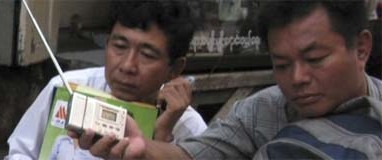 The Associated Press reports:
The Associated Press reports:
“So far, 33 new political parties have been approved by the Election Commission and five existing parties have reregistered to contest the polls. Global criticism has failed to win the freedom of detained opposition leader Aung San Suu Kyi, whose now-defunct party overwhelmingly won the last election in 1990, but was never allowed to take power.
“Under recently enacted election laws, Suu Kyi and other political prisoners — estimated at more than 2,000 — are effectively barred from taking part in the polls. Her National League for Democracy party has called the laws unfair and undemocratic and is boycotting the vote. The party was disbanded after refusing to register for the elections by a May 6 deadline.”
Break the silence, buy radios for Burma from Amnesty International on Vimeo.
The elections have been denounced as a sham designed to reinforce military rule, and the junta hasn’t announced an exact date for the vote, but others see this as a chance to call for change. Even a faction from within the disbanded NLD has applied to form a new political party, to be called the National Democratic Force, in a bid to advance the movement’s two-decade campaign to end military rule.
Amnesty organizer’s say:
“In Burma’s harsh media environment a number of courageous individuals work hard to break through the wall of censorship. Although millions tune into broadcasts daily, not everybody in Burma has access to the crucial information they provide. With your help we can break the silence for many more.”
The site says, “The humble radio can play a vital role in empowering the voting public. One radio could help a family or community learn about their rights and show them the international solidarity that Burma’s military regime works so hard to silence.”
About 12 people will use each radio, so if Amnesty reaches its target, 50,000 more people inside Burma will have access to independent news broadcasts.
Donations can be made online, but, if you want to send a check with your donation you can send it to:
Supporter Care Team
Amnesty International UK Section
The Human Rights Action Centre
17 – 25 New Inn Yard
London
EC2 3EA
Add a note saying that it’s for the Burma radio campaign
For more information, see:
Break the silence, buy radios for Burma
(Gerri will give a report on the current situation in Gaza at the Northlake Unitarian Universalist Church in Kirkland at 7 p.m. on Tuesday, June 22.)
In May, 2010, I traveled to Gaza with eight other members of Physicians for Social Responsibility to work with medical colleagues in hospitals and clinics. This land has been under siege by Israel for more than three and one half years. The passage of essential goods into and out of Gaza is severely restricted by guarded walls, fortified gates and a sea blockade enforced by Israel.
The World Food Programme reports that 80% of households in Gaza depend on international food aid. The Palestinian Health Ministry recently reported that 70% of Gaza’s residents suffer from anemia. Ard Al-Insan, a health organization in Gaza City, states that 10.4% of households in Gaza City suffer from chronic malnutrition.
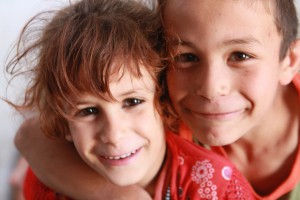
Children with normally brown hair show signs of malnutrition in reddened hair, pale skin, short stature. (photo by Bob Haynes)
Reflecting on what we heard and saw, and the possibility that there may be some positive benefits to the opening of the siege on Gaza in the wake of the Free Gaza flotilla tragedy, this article is a review of some of the critical issues and some possible solutions for the public health of Gaza.
Water
Gaza is a semi-arid land; the over-all rainfall is approximately 317 mm/year and this is decreasing through drought. (The average rainfall is Seattle is 920 mm/year.) The groundwater aquifer, sole source of water, which extends from Haifa to the Sinai, is not being adequately replenished by rainfall. Also, according to Gaza Municipalities, Israel has constructed wells along the eastern part of the Gaza strip to catch the flow of water before it enters Gaza, and Israel has built dams along the Gaza valley to collect the flow of rainwater outside of Gaza for use by Israel.
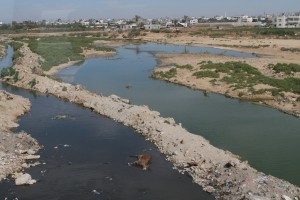
The United Nations reports that 90 – 95 percent of Gazans do not have access to clean water. (photo by Bob Haynes)
The United Nations reports that 90 – 95 percent of Gazans do not have access to clean water. Untreated and partially treated sewage is seeping into the soil and the aquifer and flowing directly into the Mediterranean.
Lacking basic equipment, spare parts and adequate electricity because of the siege by Israel, the sewage treatment system of Gaza is unable to handle the level of sewage that needs to be processed.
Fishing, a primary source of income and food in the past, is restricted by the blockade – deep water fishing is closed to Gaza and fishing in the nearby shallow, polluted water yields an inedible catch.
To remedy the water crisis, construction of sewage treatment and desalination plants will be essential. This will require access to Gaza by sea or through Israel and/or Egypt in order to bring in critically needed equipment.
Also, given the present level of unemployment and poverty (70% below the poverty line), financial aid from the international community will be required.
Air
Based on observation and anecdotal evidence, the air quality in Gaza is poor. The absence of reliable electricity (bombing by Israel of Gaza’s power plant in 2006, the unavailability of repair parts due to the siege and lack of fuel to run the functioning parts of the power plant) results in power cuts that last from four to eight hours per day for all of Gaza. The use of small, private generators is wide-spread and the resulting pollution of the air is felt throughout the region – concentrated in the cities where the population also is concentrated.
Physicians report a high incidence of burns from touching generators and pouring gasoline into generator fuel tanks and that childhood asthma is rapidly increasing. Whether the increase in asthma is caused by poor air quality or pollutants from other sources is under study.
Soil
In parts of Gaza the groundwater and the soil are contaminated with nitrites, from pesticides and sewage, and chlorides, from seawater intrusion. Both carry health risks, particularly to developing fetuses and small children.
Mental Health
The presence of the siege, profound lack of employment, death of loved ones through air and ground attacks, presence of continuing disabilities from injuries sustained in those attacks, death and injuries caused by fighting inside Gaza, and the ongoing threat of further attacks by Israel have created a sense of despair, tension and fear – and a level of hopelessness in the population of Gaza.
Every person our group spoke with had been affected by the siege and the 2008/2009 attacks by Israel. While the pervasive belief that “all things come from Allah” provides comfort, the daily life of the average person in Gaza is fraught with difficulties.
Mental health workers describe seeing what has been reported in the homes of U.S. war veterans: increased rates of episodic rage and domestic abuse. They also report high rates of depression and an inability to find hope in any activity among the people of Gaza.
However, during our visits to women’s clinics and during our work in health care facilities, a sense of resilience was palpable. Innovative efforts to overcome the health crisis go on despite desperate conditions. The Gaza Community Mental Health Programme – host to our delegation – is developing a program to teach primary care providers how to assist patients in recognizing normal responses to the abnormal situation of life in
Gaza.
Ultimately, the most essential remedy for the public health crisis in Gaza is to end the collective punishment of the population by ending the siege. Among many other things, this will allow the resumption of trade which will create jobs in Gaza and lead to the revival of hope for a healthier future.
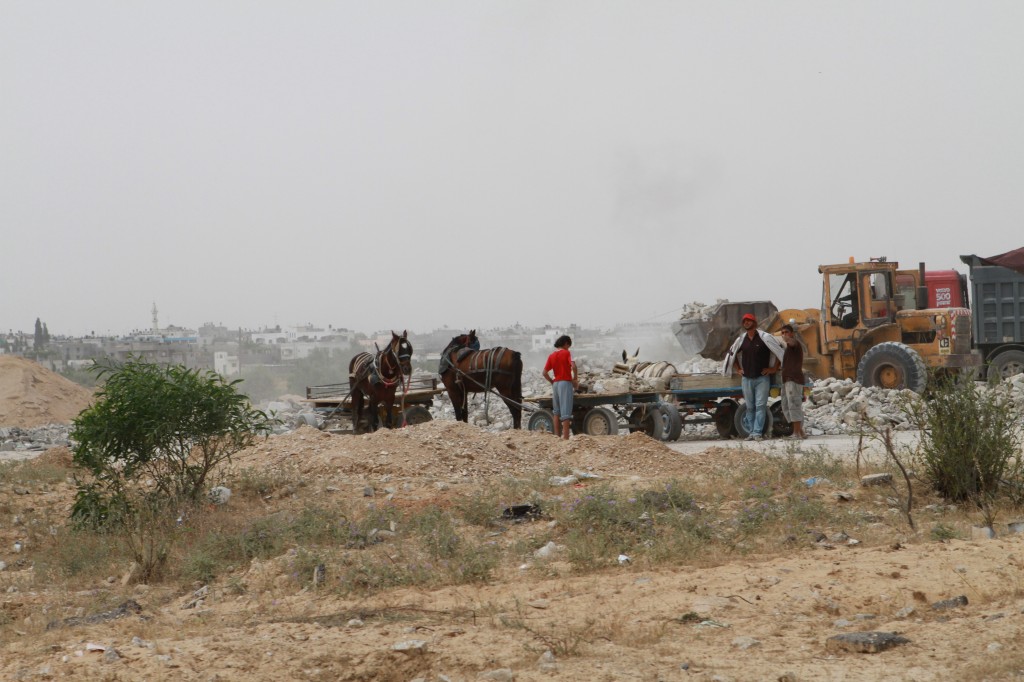
Local Palestinians harvest building materials of questionable toxicity from the rubble of bombed buildings. (photo by Bob Haynes)

